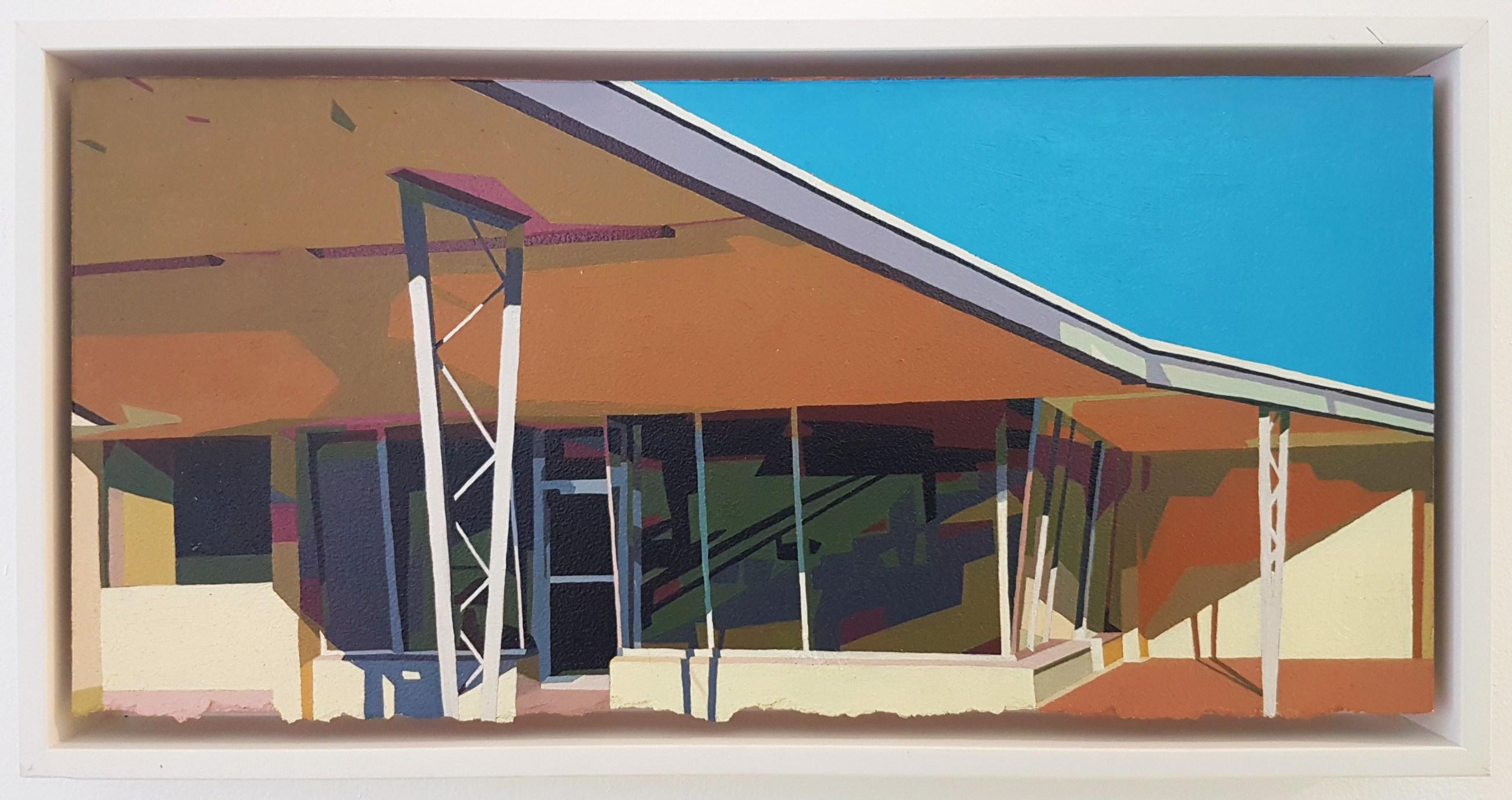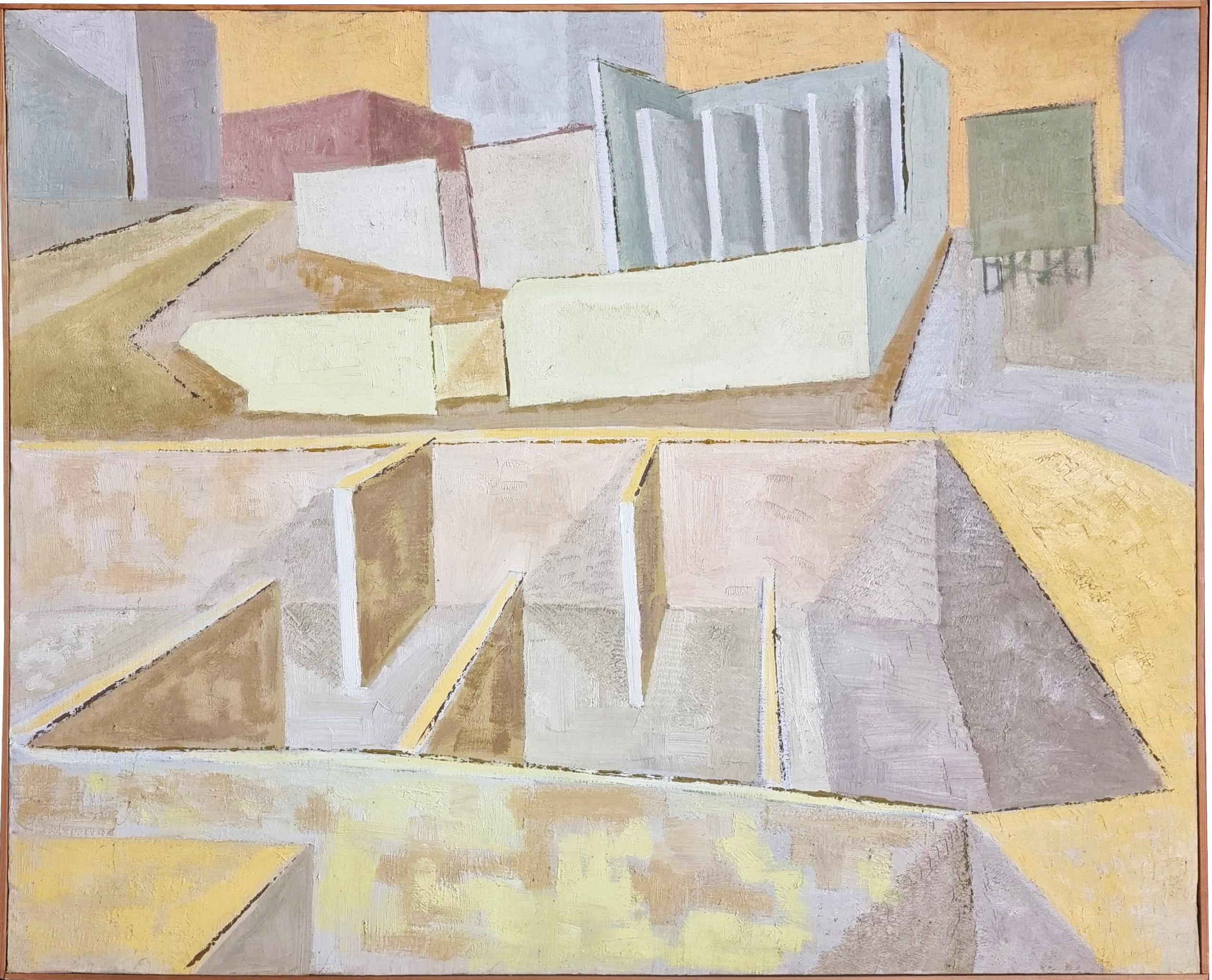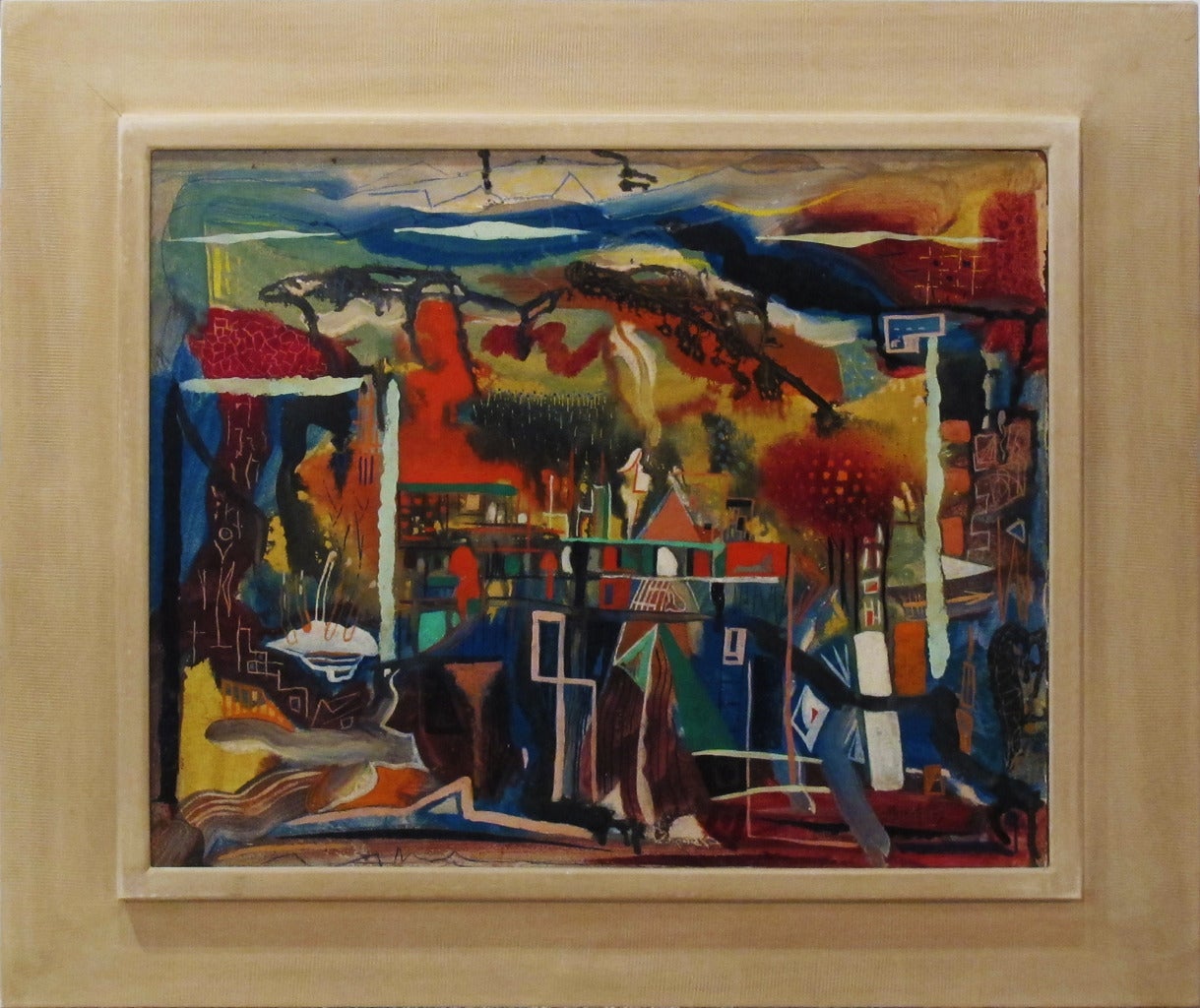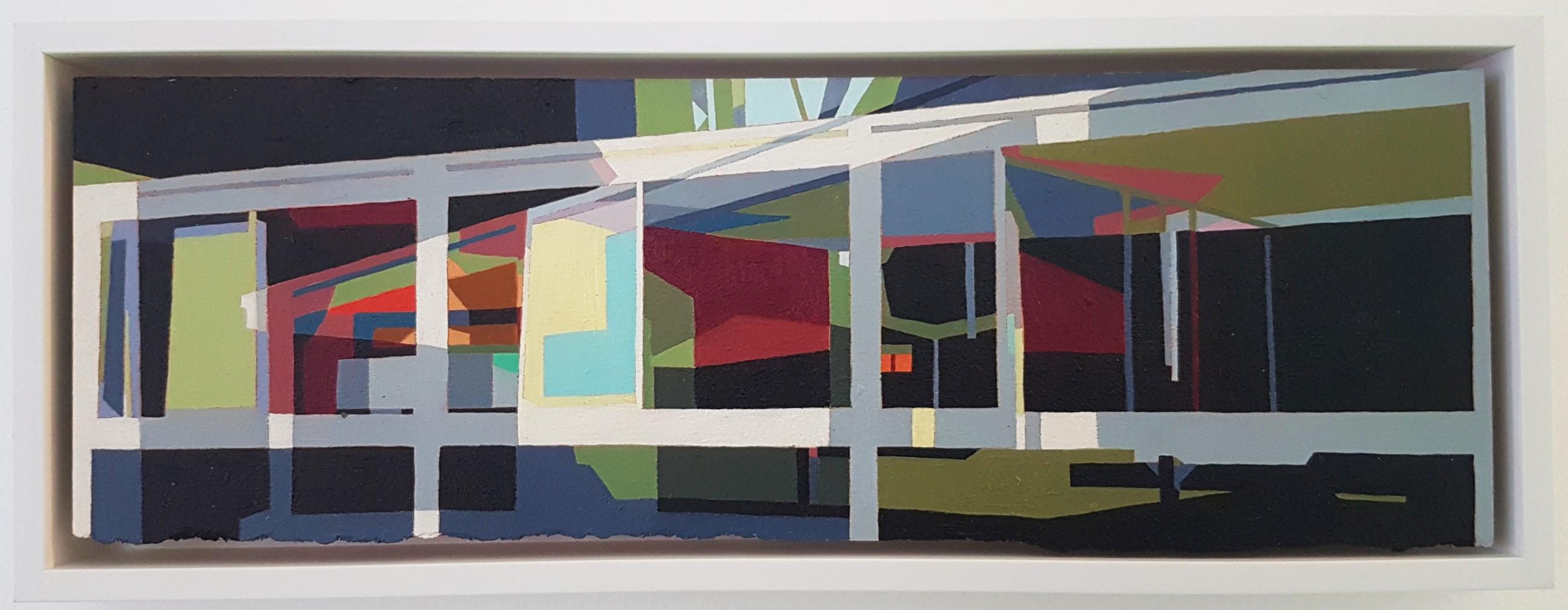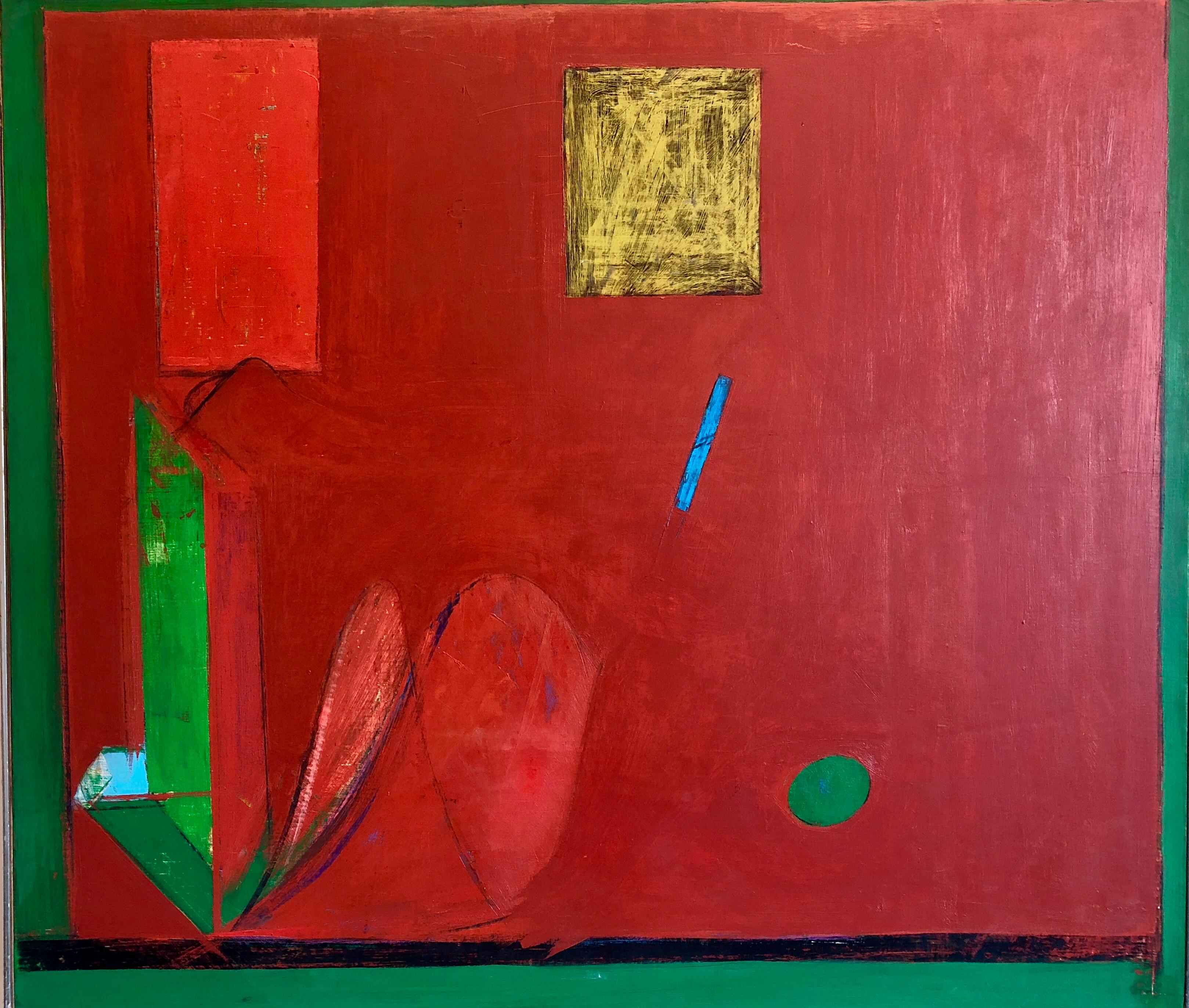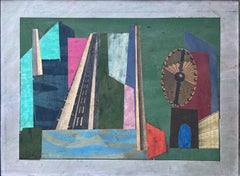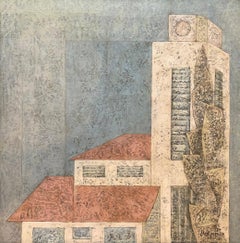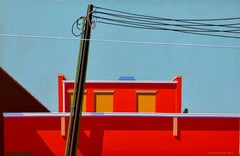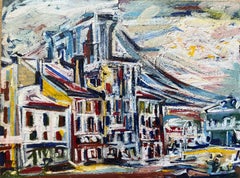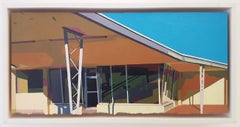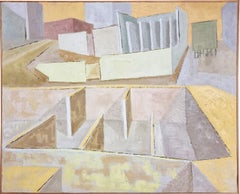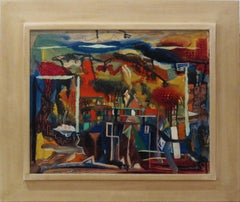Want more images or videos?
Request additional images or videos from the seller
1 of 5
Trew HockerUntitled (Elevated Platform)1950
1950
$18,000
£14,017.20
€15,944.52
CA$25,923
A$28,447.26
CHF 14,858.14
MX$340,118.58
NOK 188,204.69
SEK 175,536.29
DKK 119,083.24
About the Item
This painting is part of our current exhibition - America Coast to Coast: Artists of the 1940s
Untitled (Elevated Platform), 1950, oil on canvas, signed and dated lower right, 30 x 54 inches, presented in a period frame
Trew Hocker was an American Scene and modernist painter, who was born in Sedalia, Missouri. He studied art at the University of Missouri, the Kansas City Art Institute, and the St. Louis School of Fine Arts, as well as with Thomas Hart Benton. In 1933, Hocker began exhibiting publicly and won second prize at the Missouri State Fair. The same year he founded an arts club in his hometown, together with nine other young painters. Two years later in 1935 and then again in 1937, Hocker won additional prizes at the Missouri State Fair. Later during the Great Depression, Hocker served as a District Supervisor in the WPA arts program and exhibited at the Kansas City Art Institute. In the late 1930s, he painted very large murals depicting his home state for the New York Worlds Fair and the Golden Gate International Exposition and completed a mural for the University City, Missouri Post Office in 1940.
With the outbreak of World War II, Hocker served in the United States Army eventually earning the rank of captain. During the war, Hocker exhibited paintings in exhibitions for military personnel in the American Air Force Technical Training Command and in an exhibition entitled “Solider Art” at the National Gallery of Art in Washington D.C. In 1947 after his discharge from the Army, Hocker moved to New York City and held well publicized exhibitions of his paintings in his MacDougall Street apartment and his paintings were included in group shows at the National Academy of Design and the Brooklyn Museum. During the summer of 1948, Hocker taught together with Louis and Elsie Freund at the recently founded Art School of the Ozarks before traveling to Paris for a year of additional study at Grande Chaumiere with Fernand Leger and Andre Lhote.
After his Paris sojourn, Hocker returned to New York City where he painted Untitled (Elevated Platform). Hocker's recently acquired French training is evident in this work. There is a shift from an American Scene aesthetic to a cubist-informed modernism. Space is flattened and simplified as broad areas of color take the place of three-dimensional modeling. Hocker's figures have become angular and his palette is a striking blend of earth-toned browns and vibrant greens and blues with touches of orange and pink which creates a since of depth.
Although Hocker continued his fine art practice through the end of his life, during the 1950s, he worked primarily as a critically acclaimed set designer for television and stage, including Guys and Dolls, NBC’s Opera Theater, and Ellery Queen. Hocker’s work is in the collection of the Nelson-Atkins Museum in Kansas City. He is listed in Who Was Who in American Art and all other standard references.
- Creator:Trew Hocker (1913 - 1963, American)
- Creation Year:1950
- Dimensions:Height: 30 in (76.2 cm)Width: 54 in (137.16 cm)Depth: 3 in (7.62 cm)
- More Editions & Sizes:30 x 54 inchesPrice: $18,000
- Medium:
- Movement & Style:
- Period:
- Condition:
- Gallery Location:Los Angeles, CA
- Reference Number:1stDibs: LU1859214264102
About the Seller
5.0
Gold Seller
Premium sellers maintaining a 4.3+ rating and 24-hour response times
1stDibs seller since 2022
17 sales on 1stDibs
- ShippingRetrieving quote...Shipping from: Los Angeles, CA
- Return Policy
More From This Seller
View AllCityscape (Untitled)
Located in Los Angeles, CA
Cityscape (Untitled), c. 1950s, mixed media on board, signed lower left, 13 1/2 x 18 inches, presented in its original frame
Jean (Yanko) Varda was a Greek-born multi-media artist ...
Category
1950s American Modern Mixed Media
Materials
Paper, Oil, Photographic Paper, Board, Magazine Paper
Untitled (Highrise)
By Karl Benjamin
Located in Los Angeles, CA
Untitled (Highrise), 1954, oil on canvas, signed and dated lower right, 20 x 20 inches, presented in its original frame
Karl Benjamin was a California-based artist who is best known...
Category
1950s Hard-Edge Landscape Paintings
Materials
Canvas, Oil
Atilt
Located in Los Angeles, CA
Atilt, 1982, acrylic on canvas, 32 x 48 inches, signed and dated lower right, “Alfred P. Maurice 2725 A South Michigan Ave, Chicago, IL, 60616” inscribed verso, “ATILT” inscribed verso, “Maurice.018” inscribed on frame, exhibited: 1) Alfred P. Maurice Artist in the City Paintings 1979 - 1997, Archer Gallery of Clark College, Vancouver, WA, April 8 – April 30, 1997, #11, and 2) An Artful Life: Celebrating the Life of Creator, Teacher, and Collector Alfred Maurice...
Category
1980s American Modern Landscape Paintings
Materials
Canvas, Acrylic
Peck Slip
Located in Los Angeles, CA
Peck Slip, 1950, oil on cardboard, 15 x 20 inches, exhibition label verso reads: “Oil on cardboard, 20 x 15, 1950 / Title: Peck Slip / Price: $100 / Artist and Owner: Fiske Boyd / 30...
Category
1950s American Modern Landscape Paintings
Materials
Oil, Board
9:23 am
By Saul Chase
Located in Los Angeles, CA
9:23am, 1969, acrylic on canvas, signed and dated verso, 44 ½ x 50 inches, exhibited: 39th Midyear Show, The Butler Institute of American Art, Youngstown, Ohio, 1972 (label verso), p...
Category
1960s American Modern Landscape Paintings
Materials
Canvas, Oil
$20,000
On a Spanish Motif
Located in Los Angeles, CA
On a Spanish Motif, 1956 – 1973, mixed media collage and painting on thick canvas, signed and dated lower right, 38 ½ x 26 inches, signed verso, labeled verso includes title, artist's name, address and size of work, presented in its original strip frame
Justin Faivre...
Category
1950s Abstract Mixed Media
Materials
Metal
You May Also Like
Platform
Located in San Francisco, CA
This artwork titled "Platform" 1963 is an original silkscreen by American artist Kenneth William Auvil, 1925-1999. It is signed, dated, titled and numbered 9/27 in pencil by the artist. The image size is 17 x 11.25 inches, framed size is 23.5 x 17.65 inches. Custom framed in a bronze color metal frame. It is in good condition, paper is slightly toned by age.
About the artist:
Educational Background
University of Washington, 1953 MFA Art
University of Washington, 1949 BA Art
Teaching Experience
San Jose State University, 1956 -1988
Selected Publications
Serigraphy: Silk Screen Techniques for the Artist, Prentice‑Hall, 1965‑1996.
Activities: Learning to Use the Macintosh Computer...
Category
Mid-20th Century American Modern More Prints
Materials
Screen
Station #3
By John Ferry
Located in Kansas City, MO
John Ferry
Station #3
Medium: Oil on Panel
Year: 2019
Size: 7.5x16 in
Signed, dated and inscribed by hand
Framed
COA provided
Ref.: JF-19-04
“Ferry’s works...
Category
2010s Contemporary Paintings
Materials
Oil, Panel
Untitled (Geometric Abstraction, Cityscape, Feyninger)
Located in Kansas City, MO
Unknown Artist
Untitled (Geometric Abstraction, Cityscape, Feyninger)
Medium: Oil on Canvas
Year: Circa 1970s
Size: 39 x 48 inches
Framed Size: 39.75 x 48.5 x 1 inches
Unsigned
Frame...
Category
1970s Modern Paintings
Materials
Canvas, Oil
$1,900 Sale Price
47% Off
"Modern Industry"
By Joseph Meierhans
Located in Lambertville, NJ
Signed lower right
Category
1940s Abstract Paintings
Materials
Masonite, Oil
Modern X2 #2
By John Ferry
Located in Kansas City, MO
John Ferry
Modern X2 #2
Medium: Oil on Panel
Year: 2019
Size: 5.75x16.5 in
Signed, dated and inscribed by hand
Framed
COA provided
Ref.: JF-19-35
“Ferry’s...
Category
2010s Modern Paintings
Materials
Oil, Panel
Untitled
Located in Summit, NJ
Gorgeous oil on wood by 20th century American painter Don Smith. The piece is a beautiful candy apple red color with a grass green border and touches of cobalt blue, mustard yellow ...
Category
1960s Abstract Paintings
Materials
Wood, Oil
More Ways To Browse
Missouri Art
Paris Street Scene Painting Large Canvas Painting
Vintage Television Sets
Scenes From Vintage America
Opera Dolls
Louis Freund
Large Vintage Canvas Art
Portrait Of A Lady
Puerto Rico
French Blue Painting
Lake Landscape Paintings
Village Oil Painting
Still Life With Fruits Painting
Antique Unframed Canvas Paintings
Jewish Museum
Flower Vase Oil On Canvas
French Floral Still Life Painting
Heart Painting
